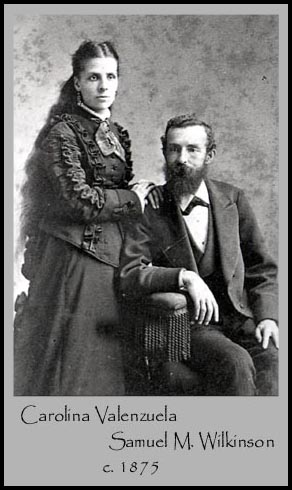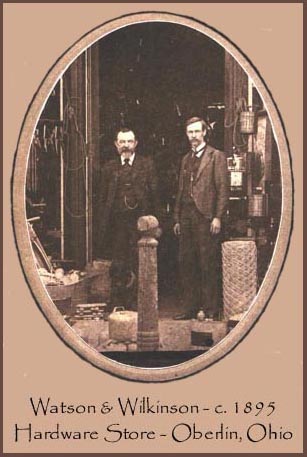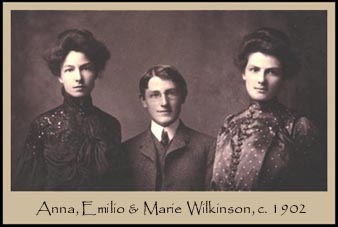Introduction
 What follows is a collection of newspaper articles, written by Samuel M. Wilkinson, published in The Mansfield Herald
(Mansfield, Ohio) and The Monroeville Spectator (Monroeville, Ohio). Samuel was a correspondent of the Herald
from 1861 to 1876, his articles were published under the pseudonym “Damon.” From 1876 to 1886 he was the proprietor and
sometimes editor of the Spectator.
What follows is a collection of newspaper articles, written by Samuel M. Wilkinson, published in The Mansfield Herald
(Mansfield, Ohio) and The Monroeville Spectator (Monroeville, Ohio). Samuel was a correspondent of the Herald
from 1861 to 1876, his articles were published under the pseudonym “Damon.” From 1876 to 1886 he was the proprietor and
sometimes editor of the Spectator.
Samuel wrote primarily about his life experiences; which included serving in the early days of the Civil War, and spending nearly 30
years in Mexico as superintendent of two silver mines owned by his uncle. In addition to stories about army life and Mexico,
the collection includes a few poems, a short story, and some miscellaneous articles and editorials.
Samuel’s writing style was similar to Mark Twain’s: humorously satirical. His articles are entertaining, in
addition to providing a first person account of life in the late 1800’s, describing a life unfamiliar to most Americans
today. Before the invention of the automobile and the airplane, before there was a transcontinental railroad or the
Panama Canal, a journey from Ohio to the Mexican silver mines was an adventure that could take 3 months. Samuel made the
trip enjoyable—for the reader—happy that Samuel took the trip, and lived to write about it, and the reader got to stay home and not
suffer through the many travails of the trip.
Members of Samuel’s family, other than John R. Robinson, were infrequently written about in his articles. Mr. Robinson is written
about frequently as they spent nearly 30 years working and traveling together. His children by Carolina, and his sister Belle,
were mentioned in the Spectator article of July 5, 1883. In the Spectator article of September 11, 1879 Carolina
is briefly mentioned, and in the Spectator article of March 1, 1877, his description of a young woman he met on an earlier journey
to Mexico is very similar to other descriptions of Carolina, although he doesn’t say that it is his future wife. One of
Samuel’s brothers, Edward W. Wilkinson, spent 2˝ years at the Batopilas mine and 1˝ years at the Santa Eulalia mine, he is written about
in a few articles. His brother William (referred to as Harry), gets a few mentions as well.
The “Life in Mexico” articles in the Spectator are sometimes repetitions of articles in the Herald with some slight
changes. When Samuel wrote in the Herald he frequently mentioned Mansfield people and places, as he had lived there
most of his life up to that time. Not so in the Spectator, he had spent very little time in Monroeville and did not
have the local knowledge to add to his articles.
———— Biography ————
 Samuel was born Christmas Day, 1837, in Cincinnati, Ohio, the oldest of the seven children of James W. Wilkinson and Elizabeth B.
Mason. The family moved to Mansfield, Ohio when Samuel was a young child. He attended the public schools in Mansfield
until age fifteen when he went to work as a bookkeeper for his uncle, John R. Robinson, who was superintendent of the Sandusky,
Mansfield and Newark railroad. At the outbreak of the Civil War in 1861, he joined the 15th Ohio Volunteer Infantry as a
sergeant. He left the service after his three months enlistment ended in August 1861. In 1862 he went to Batopilas,
Mexico, where John R. Robinson had purchased a silver mine. Over the next 28 years most of Samuel’s life was spent in Mexico
as superintendent of silver mines owned by his uncle. He would return to Ohio every few years and spent up to two years
there before returning to Mexico. During one of his trips to Ohio in 1876, he purchased the Spectator and was the
editor of the paper until
he returned to Mexico in 1877. He retained ownership of the paper until 1886, although most of the time he was in
Mexico. His brother, William Henry Harrison Wilkinson, ran the paper and was editor while Samuel was in Mexico. In
1880 John R. Robinson sold the Batopilas silver mine, and purchased another mine at Santa Eulalia, near Chihuahua, Mexico. Samuel
remained at the Batopilas mine until 1883, working for the new owner, Alex R. Shepherd. He then went to work at his uncle’s
Santa Eulalia mine and remained there until about 1890. He moved back to Ohio after the silver mine was sold, first settling in
Geneva, where he was part owner of the Geneva Free Press. About 1894 Samuel moved to Oberlin, where he lived the rest of his life as a partner in the hardware store, Wilkinson & Watson, until
his death in 1900. He was buried in the Mansfield Cemetery.
Samuel was born Christmas Day, 1837, in Cincinnati, Ohio, the oldest of the seven children of James W. Wilkinson and Elizabeth B.
Mason. The family moved to Mansfield, Ohio when Samuel was a young child. He attended the public schools in Mansfield
until age fifteen when he went to work as a bookkeeper for his uncle, John R. Robinson, who was superintendent of the Sandusky,
Mansfield and Newark railroad. At the outbreak of the Civil War in 1861, he joined the 15th Ohio Volunteer Infantry as a
sergeant. He left the service after his three months enlistment ended in August 1861. In 1862 he went to Batopilas,
Mexico, where John R. Robinson had purchased a silver mine. Over the next 28 years most of Samuel’s life was spent in Mexico
as superintendent of silver mines owned by his uncle. He would return to Ohio every few years and spent up to two years
there before returning to Mexico. During one of his trips to Ohio in 1876, he purchased the Spectator and was the
editor of the paper until
he returned to Mexico in 1877. He retained ownership of the paper until 1886, although most of the time he was in
Mexico. His brother, William Henry Harrison Wilkinson, ran the paper and was editor while Samuel was in Mexico. In
1880 John R. Robinson sold the Batopilas silver mine, and purchased another mine at Santa Eulalia, near Chihuahua, Mexico. Samuel
remained at the Batopilas mine until 1883, working for the new owner, Alex R. Shepherd. He then went to work at his uncle’s
Santa Eulalia mine and remained there until about 1890. He moved back to Ohio after the silver mine was sold, first settling in
Geneva, where he was part owner of the Geneva Free Press. About 1894 Samuel moved to Oberlin, where he lived the rest of his life as a partner in the hardware store, Wilkinson & Watson, until
his death in 1900. He was buried in the Mansfield Cemetery.
 The details are sketchy, but it appears that between 1865 and 1871 Samuel fathered four children by Mariana Hernandez, in
Batopilas. It is unclear whether he was ever married to her, as he never brought her or their children with him on any of
his trips back to Ohio. About 1874 he married Carolina Valenzuela, in Chois, Mexico; they produced three children.
Their first daughter, Anna, was born in Batopilas, in 1875. After Anna was born, Samuel brought his wife and daughter to
Ohio. Their second daughter, Marie, was born in Ohio, in 1877. Samuel, Carolina and Marie returned to Mexico later
that year, Anna remaining in Ohio with Samuel’s mother and sisters. Their son, Emilio, was born in Batopilas in 1879.
Carolina died in 1880, in Batopilas. In 1881 Samuel’s sister Belle traveled to Mexico bringing Anna with her, and in 1883
Samuel brought his three children by Carolina and his sister to Ohio. His children stayed in Ohio when he returned to Mexico
and were raised by his sisters, until his return to Ohio in 1890.
The details are sketchy, but it appears that between 1865 and 1871 Samuel fathered four children by Mariana Hernandez, in
Batopilas. It is unclear whether he was ever married to her, as he never brought her or their children with him on any of
his trips back to Ohio. About 1874 he married Carolina Valenzuela, in Chois, Mexico; they produced three children.
Their first daughter, Anna, was born in Batopilas, in 1875. After Anna was born, Samuel brought his wife and daughter to
Ohio. Their second daughter, Marie, was born in Ohio, in 1877. Samuel, Carolina and Marie returned to Mexico later
that year, Anna remaining in Ohio with Samuel’s mother and sisters. Their son, Emilio, was born in Batopilas in 1879.
Carolina died in 1880, in Batopilas. In 1881 Samuel’s sister Belle traveled to Mexico bringing Anna with her, and in 1883
Samuel brought his three children by Carolina and his sister to Ohio. His children stayed in Ohio when he returned to Mexico
and were raised by his sisters, until his return to Ohio in 1890.
———— Notes on transcription ————
The articles have been transcribed from microfilm records of the newspapers. The intent of the transcription was to reproduce
the articles as they had been published more than 125 years ago. All misspellings, grammatical errors and other mistakes are
left in without any notation. In some cases the quality of the microfilm is poor and a few words cannot be determined, or
part of a page is damaged. These cases will be noted by square brackets – [ ], blank
for an illegible word, or enclosing a note describing the damage.
The letters have been transcribed from scanned copies of the original letters. Again, the intent of the transcription was to
reproduce the letters as they had been written. The same use of square brackets as for the newspaper transcriptions apply,
with some leniency towards guessing at words that were difficult to read. The scanned copies of the letters are also included,
along with some notes that have been added.
 What follows is a collection of newspaper articles, written by Samuel M. Wilkinson, published in The Mansfield Herald
(Mansfield, Ohio) and The Monroeville Spectator (Monroeville, Ohio). Samuel was a correspondent of the Herald
from 1861 to 1876, his articles were published under the pseudonym “Damon.” From 1876 to 1886 he was the proprietor and
sometimes editor of the Spectator.
What follows is a collection of newspaper articles, written by Samuel M. Wilkinson, published in The Mansfield Herald
(Mansfield, Ohio) and The Monroeville Spectator (Monroeville, Ohio). Samuel was a correspondent of the Herald
from 1861 to 1876, his articles were published under the pseudonym “Damon.” From 1876 to 1886 he was the proprietor and
sometimes editor of the Spectator. Samuel was born Christmas Day, 1837, in Cincinnati, Ohio, the oldest of the seven children of James W. Wilkinson and Elizabeth B.
Mason. The family moved to Mansfield, Ohio when Samuel was a young child. He attended the public schools in Mansfield
until age fifteen when he went to work as a bookkeeper for his uncle, John R. Robinson, who was superintendent of the Sandusky,
Mansfield and Newark railroad. At the outbreak of the Civil War in 1861, he joined the 15th Ohio Volunteer Infantry as a
sergeant. He left the service after his three months enlistment ended in August 1861. In 1862 he went to Batopilas,
Mexico, where John R. Robinson had purchased a silver mine. Over the next 28 years most of Samuel’s life was spent in Mexico
as superintendent of silver mines owned by his uncle. He would return to Ohio every few years and spent up to two years
there before returning to Mexico. During one of his trips to Ohio in 1876, he purchased the Spectator and was the
editor of the paper until
he returned to Mexico in 1877. He retained ownership of the paper until 1886, although most of the time he was in
Mexico. His brother, William Henry Harrison Wilkinson, ran the paper and was editor while Samuel was in Mexico. In
1880 John R. Robinson sold the Batopilas silver mine, and purchased another mine at Santa Eulalia, near Chihuahua, Mexico. Samuel
remained at the Batopilas mine until 1883, working for the new owner, Alex R. Shepherd. He then went to work at his uncle’s
Santa Eulalia mine and remained there until about 1890. He moved back to Ohio after the silver mine was sold, first settling in
Geneva, where he was part owner of the Geneva Free Press. About 1894 Samuel moved to Oberlin, where he lived the rest of his life as a partner in the hardware store, Wilkinson & Watson, until
his death in 1900. He was buried in the Mansfield Cemetery.
Samuel was born Christmas Day, 1837, in Cincinnati, Ohio, the oldest of the seven children of James W. Wilkinson and Elizabeth B.
Mason. The family moved to Mansfield, Ohio when Samuel was a young child. He attended the public schools in Mansfield
until age fifteen when he went to work as a bookkeeper for his uncle, John R. Robinson, who was superintendent of the Sandusky,
Mansfield and Newark railroad. At the outbreak of the Civil War in 1861, he joined the 15th Ohio Volunteer Infantry as a
sergeant. He left the service after his three months enlistment ended in August 1861. In 1862 he went to Batopilas,
Mexico, where John R. Robinson had purchased a silver mine. Over the next 28 years most of Samuel’s life was spent in Mexico
as superintendent of silver mines owned by his uncle. He would return to Ohio every few years and spent up to two years
there before returning to Mexico. During one of his trips to Ohio in 1876, he purchased the Spectator and was the
editor of the paper until
he returned to Mexico in 1877. He retained ownership of the paper until 1886, although most of the time he was in
Mexico. His brother, William Henry Harrison Wilkinson, ran the paper and was editor while Samuel was in Mexico. In
1880 John R. Robinson sold the Batopilas silver mine, and purchased another mine at Santa Eulalia, near Chihuahua, Mexico. Samuel
remained at the Batopilas mine until 1883, working for the new owner, Alex R. Shepherd. He then went to work at his uncle’s
Santa Eulalia mine and remained there until about 1890. He moved back to Ohio after the silver mine was sold, first settling in
Geneva, where he was part owner of the Geneva Free Press. About 1894 Samuel moved to Oberlin, where he lived the rest of his life as a partner in the hardware store, Wilkinson & Watson, until
his death in 1900. He was buried in the Mansfield Cemetery. The details are sketchy, but it appears that between 1865 and 1871 Samuel fathered four children by Mariana Hernandez, in
Batopilas. It is unclear whether he was ever married to her, as he never brought her or their children with him on any of
his trips back to Ohio. About 1874 he married Carolina Valenzuela, in Chois, Mexico; they produced three children.
Their first daughter, Anna, was born in Batopilas, in 1875. After Anna was born, Samuel brought his wife and daughter to
Ohio. Their second daughter, Marie, was born in Ohio, in 1877. Samuel, Carolina and Marie returned to Mexico later
that year, Anna remaining in Ohio with Samuel’s mother and sisters. Their son, Emilio, was born in Batopilas in 1879.
Carolina died in 1880, in Batopilas. In 1881 Samuel’s sister Belle traveled to Mexico bringing Anna with her, and in 1883
Samuel brought his three children by Carolina and his sister to Ohio. His children stayed in Ohio when he returned to Mexico
and were raised by his sisters, until his return to Ohio in 1890.
The details are sketchy, but it appears that between 1865 and 1871 Samuel fathered four children by Mariana Hernandez, in
Batopilas. It is unclear whether he was ever married to her, as he never brought her or their children with him on any of
his trips back to Ohio. About 1874 he married Carolina Valenzuela, in Chois, Mexico; they produced three children.
Their first daughter, Anna, was born in Batopilas, in 1875. After Anna was born, Samuel brought his wife and daughter to
Ohio. Their second daughter, Marie, was born in Ohio, in 1877. Samuel, Carolina and Marie returned to Mexico later
that year, Anna remaining in Ohio with Samuel’s mother and sisters. Their son, Emilio, was born in Batopilas in 1879.
Carolina died in 1880, in Batopilas. In 1881 Samuel’s sister Belle traveled to Mexico bringing Anna with her, and in 1883
Samuel brought his three children by Carolina and his sister to Ohio. His children stayed in Ohio when he returned to Mexico
and were raised by his sisters, until his return to Ohio in 1890.